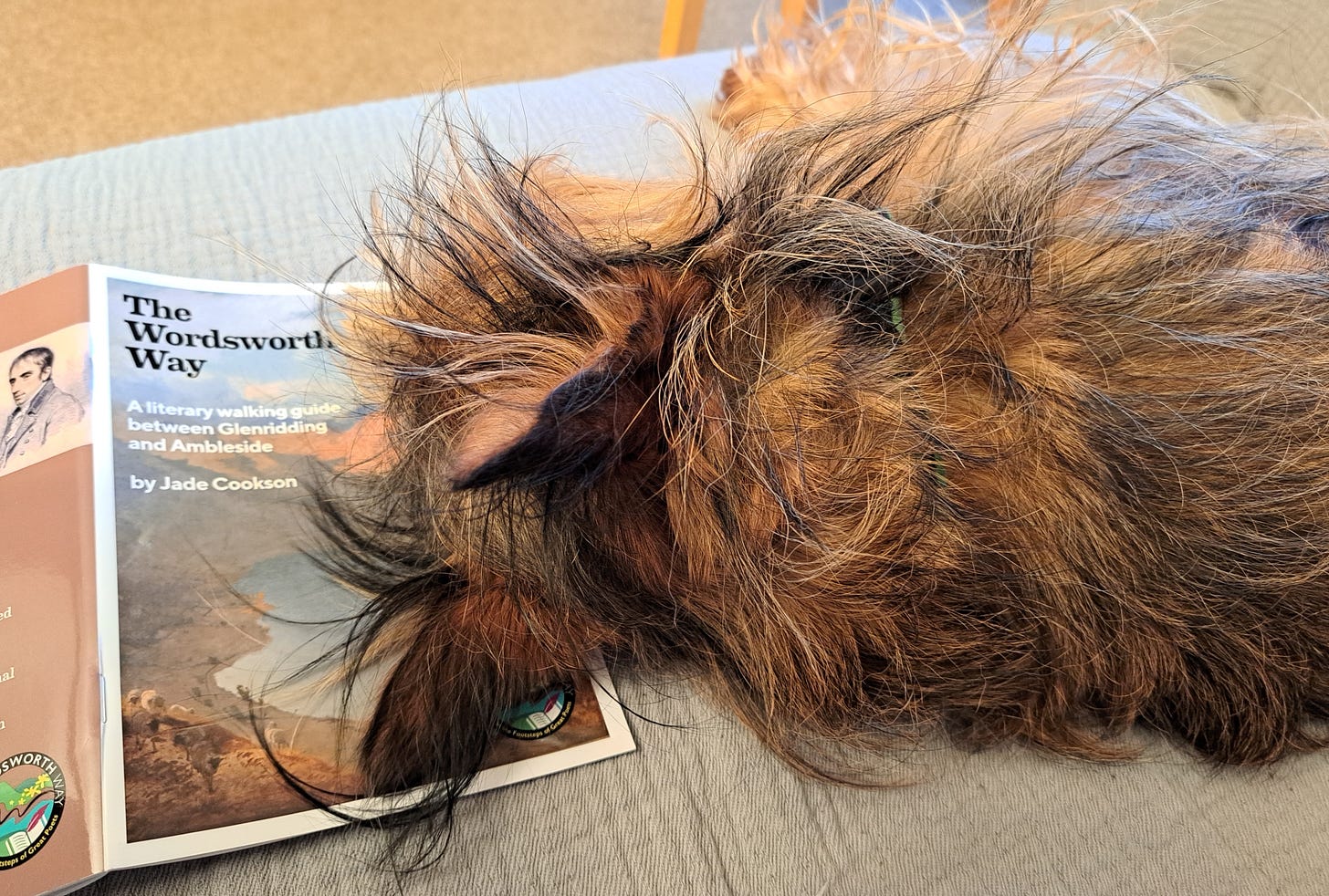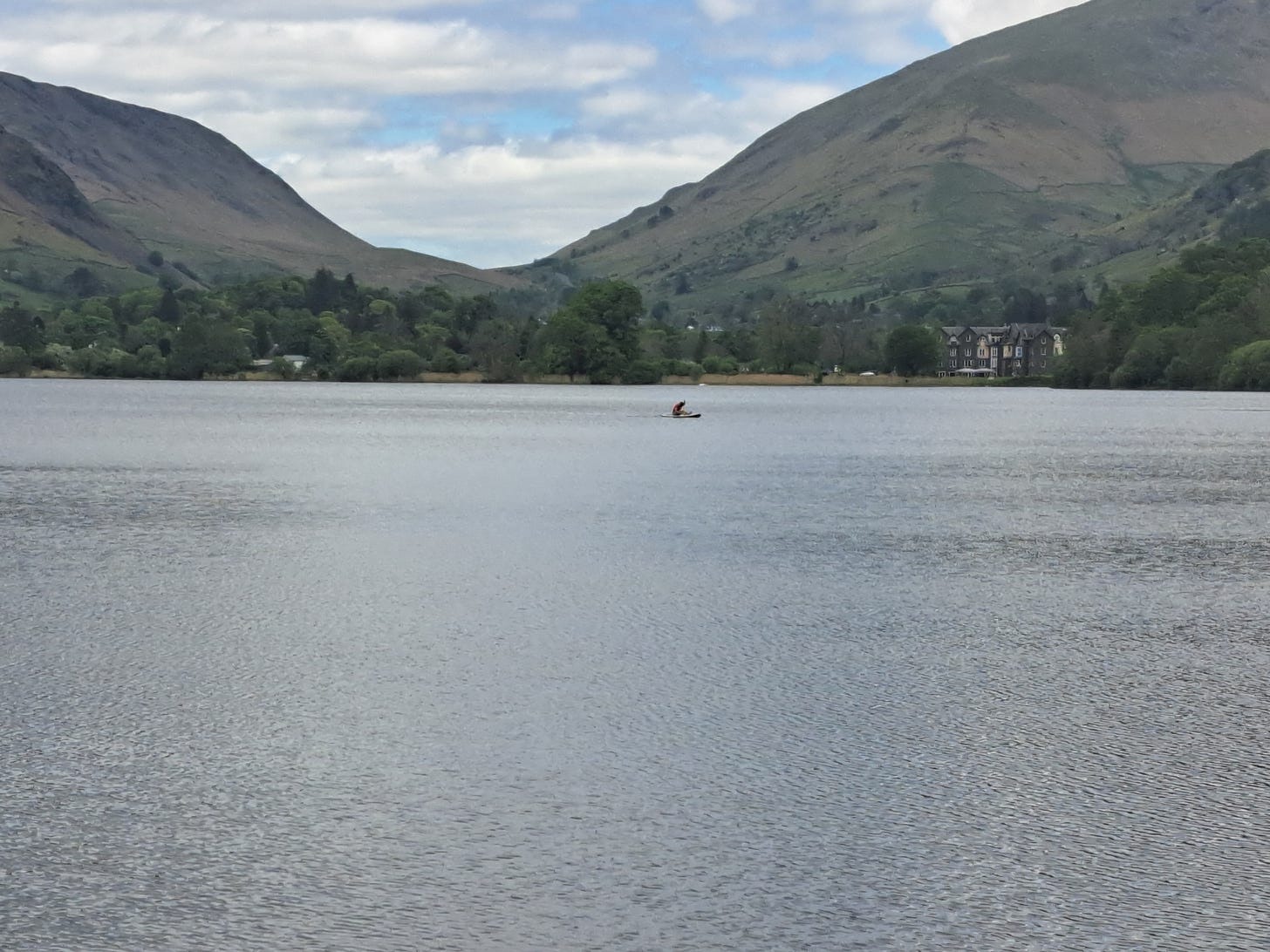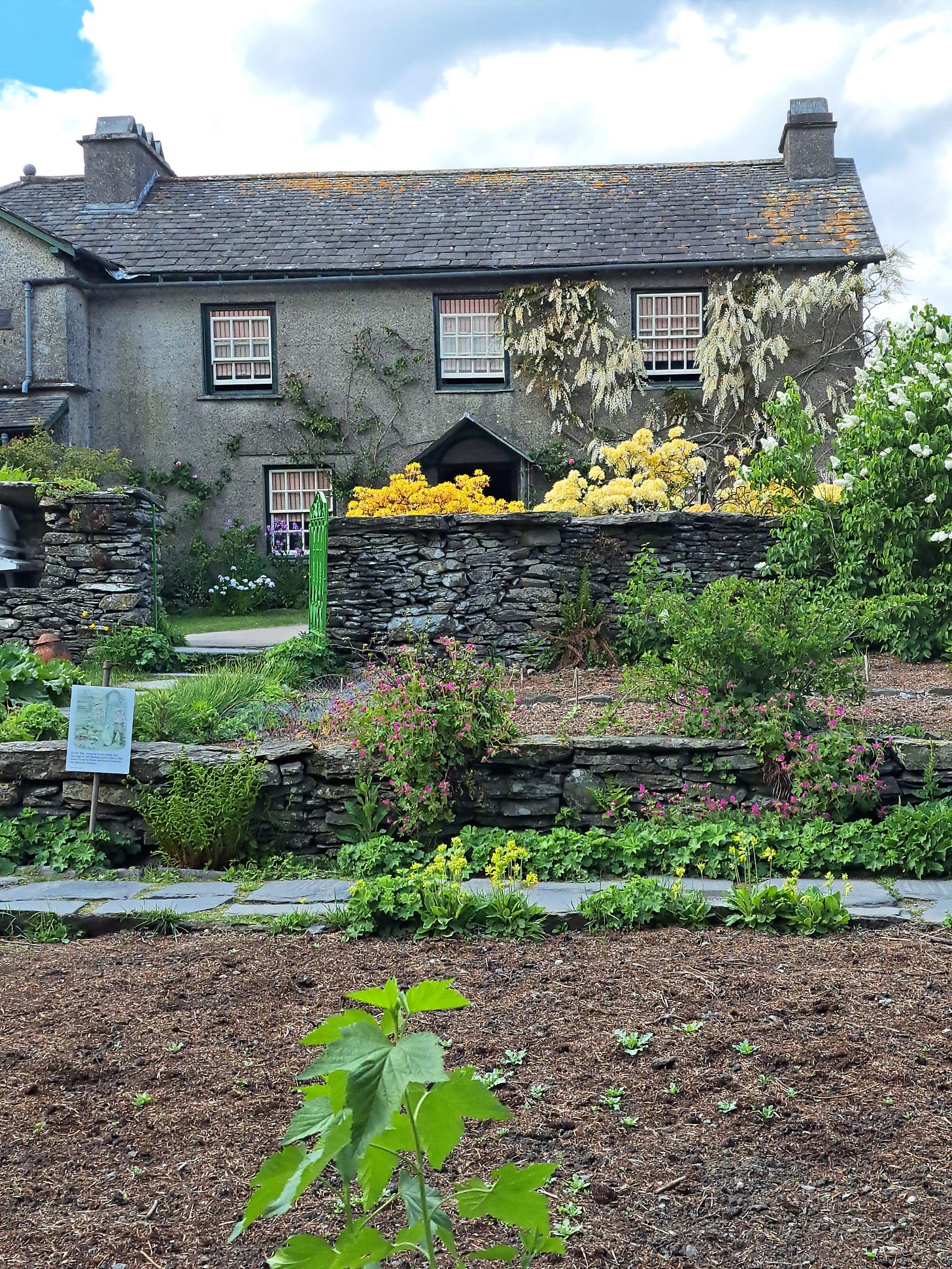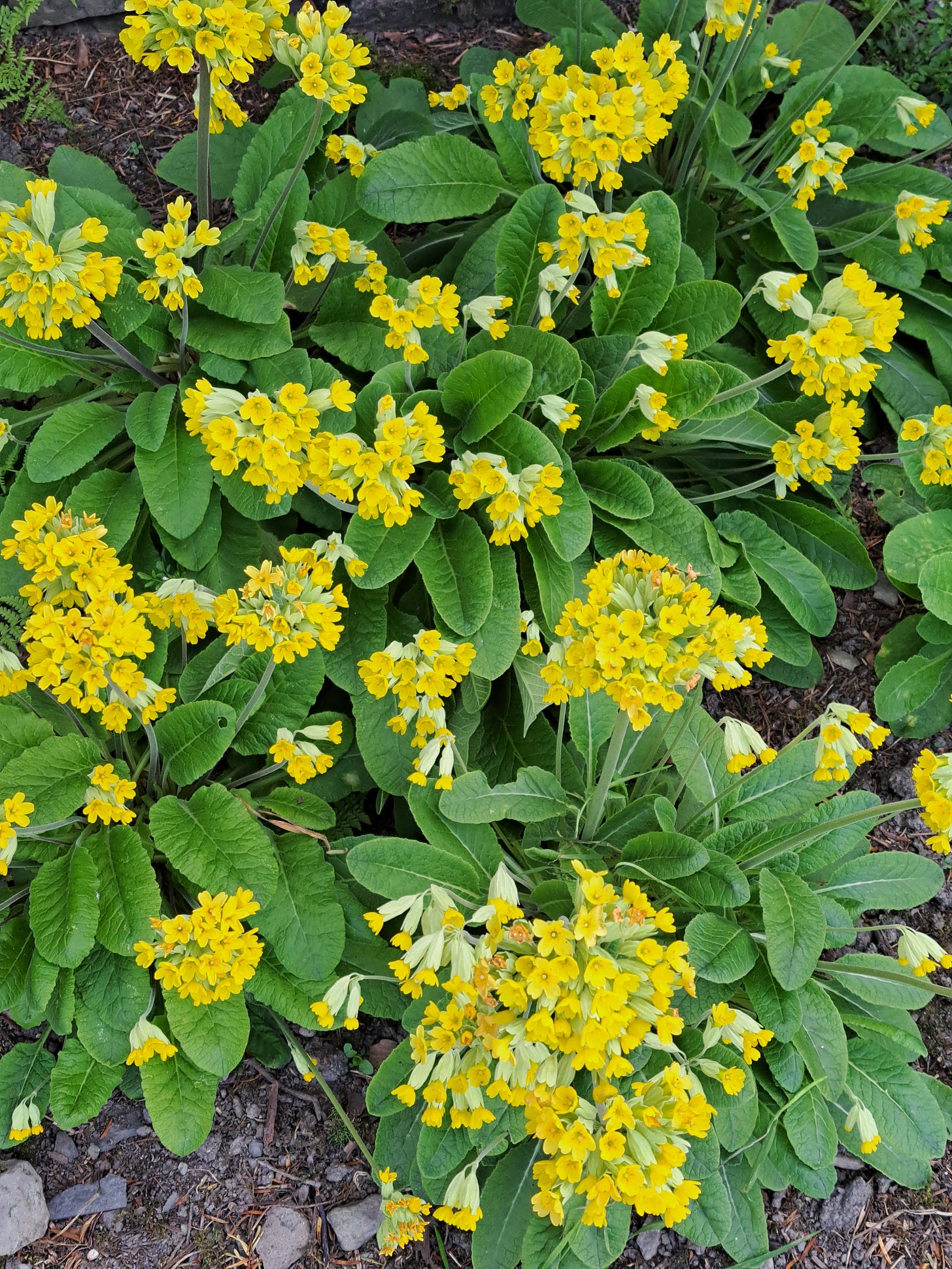The Mountains and Lakes of the Mind
Why are certain writers drawn to the landscape of Cumbria made famous by Wordsworth and his peers?
Welcome Readers to what will be for the foreseeable future the last of my fortnightly blogs. I have enjoyed researching and writing What’s the Story? but now I need to devote my energies to some other extended projects, reading and writing, and specifically preparation for a master’s degree course at the University of Cumbria.
I little thought when I returned to the Lake District ten days ago that by the time I came home I would be signed up for further study. It’s all Percy’s fault! Those of you who have been here from the beginning may recall that my first newsletter discussed stories told from the point of view of dogs. It featured a photograph of my Patterdale terrier, Percy. I promised that dogs would not appear again. However, it seems fitting to end as I began, at least briefly.
Percy found us, not the other way around. Having taken him home from the woods where he had been wandering for three days alone, we discovered that he was a Patterdale terrier, named for a village in the Lake District. We decided a visit was in order. The whole area is so breathtakingly beautiful that we visited again and, for a third time, last week. On this trip, sadly, Percy was not with us. I scattered his ashes in the river that runs through Patterdale to join the Ullswater.
This time, too, we had new walking paths to follow in the form of the Wordsworth Way.
On our previous visits I had come to appreciate Wordsworth’s poetry for its radical tone, (at least in the early work) inspired by the ideals of the French Revolution, its spiritual apprehension of the natural world, and its stories of people he encountered, many of them bereaved by the Napoleonic wars and by the departure of their children to work in the cities. I also became acquainted with Dorothy whose journals are fascinating for her observations of her surroundings, the sheer physical stamina she displays in her tireless walking for miles over hill and dale, and her close involvement in her brother’s creative output.
The guidebook to the Wordsworth Way started out as a research project by Jade Cookson, a student on the MA, Romanticism and the English Lake District. It traces routes walked by the Wordsworths and outlines the history of houses owned by their friends and neighbours whose names appear in their writing. Apart from S.T. Coleridge and Robert Southey, Matthew Arnold and his sister, Mary Augusta, who wrote under the name Mrs. Humphry Ward, also lived there for a time, in a house called Fox How. Both wrote about the area. More recently, and new to me, the poet Norman Nicholson was born there in 1914 and never left.
What is it about the Lake District that inspires so many writers? I’ll be better able to answer that question at the end of the course but here’s an opening shot based on my superficial reading to date and my impressions of the place.
And yes, I know that what we see there today is an area that has been preserved, first by the work of Beatrix Potter and her husband William Heelis, who bought and protected farmland from development, effectively creating the National Trust. Now the area is a UNESCO world heritage site, making it at one level a museum but at another a crucial stay against ecodisaster. The word landscape doesn’t really capture the scale of an environment whose rough hills have a dramatic power, offset by the mysterious depths of the lakes and the tarns, large pools like eyes sunk into the vales.
Here’s the man himself, having stolen a boat, discovered by ‘unexpected chance’ in Patterdale:
I dipp’d my oars into the silent Lake, And, as I rose upon the stroke, my Boat Went heaving through the water, like a Swan; When from behind that craggy Steep, till then The bound of the horizon, a huge Cliff As if with voluntary power instinct, Uprear’d its head. I struck, and struck again, And, growing still in stature, the huge Cliff Rose up between me and the stars, and still, With measured motion, like a living thing, Strode after me. (from ‘The Prelude’)
In the breathless repetition of the ‘st’ sounds, (stroke, Steep, instinct, struck, still, stature, stars, Strode) the boy’s panic ratchets up yet the ‘huge Cliff’ does not recede and the ‘measured motion’ of the poem takes on the sinister aspect conjured by the boy’s imagination. This I think is part of the fascination of this place, that its timeless presence merges with a certain type of suggestible imagination.
Norman Nicholson finds a similar vital force in this hinterland:
. . . A wall walks slowly, At each give of the ground, Each creak of the rock’s ribs, It puts its foot gingerly, Arches its hog-holes, Lets cobble and knee-joint Settle and grip. As the slipping fellside Erodes and drifts, The wall shifts with it, Is always on the move. They built a wall slowly, A day a week; Built it to stand, But not stand still. They built a wall to walk. (from ‘Wall’)
The poem, a man-made structure like the wall, gauges its rhythm, ‘to stand/But not stand’, by the tectonic movement of the hills.
The physical power of these fells and dales is offset by the fine delicacy of the flora and fauna that live there. Dorothy Wordsworth takes great delight in documenting the plants she sees in her garden and her walks. Famously, she set down her impressions of the daffodils which became the subject of one of William’s best known poems:
I never saw daffodils so beautiful they grew among the mossy stones about & about them, some rested their heads upon these stones as on a pillow for weariness & the rest tossed & reeled & danced & seemed as if they verily laughed with the wind that blew upon them over the Lake, they looked so gay ever glancing ever changing.
(from Grasmere Journal, Thursday 15 April 1802)
For all the gaiety of this scene, the day was ‘cheerless and gloomy’ and the intrepid pair continued walking till they came to an inn where Dorothy where the landlady ‘looked sour but it is her way’. Life in the dales is not all dancing daffodils but they would not have exchanged it for any other place.
Mrs. Humphry Ward also takes a cue from these bright flowers in Helbeck of Bannisdale (1898):
Never were daffodils in such a wealth before! They were flung on the fell-side through a score of acres, in sheets and tapestries of gold,—such an audacious, unreckoned plenty as went strangely with the frugal air and temper of the northern country, with the bare walled fields, the ruggedness of the crags above, and the melancholy of the treeless marsh below. And within this common lavishness, all possible delicacy, all possible perfection of the separate bloom and tuft—each foot of ground had its own glory. For below the daffodils there was a carpet of dark violets, so dim and close that it was their scent first betrayed them; and as Laura lay gathering with her face among the flowers, she could see behind their gold, and between the hazel stems, the light-filled greys and azures [my italics] of the mountain distance. Each detail in the happy whole struck on the girl's eager sense and made there a poem of northern spring—spring as the fell-country sees it, pure, cold, expectant, with flashes of a blossoming beauty amid the rocks and pastures, unmatched for daintiness and joy. Presently Laura found herself sitting—half crying!—on a mossy tuft, looking along the wood to the distance. What was it in this exquisite country that seized upon her so—that spoke to her in this intimate, this appealing voice?
What indeed! Laura Fountain is a semi-pagan girl admired by the strict Catholic Alan Helbeck, happier inhaling the scent of the flowers than the incense in the church. I have italicised one phrase in this quote because strangely it is echoed in a poem by Mary Ward’s brother, Matthew Arnold:
. . . Behind, a buried vale doth sleep, Far down the torrent cleaves its way: In front the dumb rock rises steep, A fretted wall of blue and grey; [my italics] Of shooting cliff and crumbled stone With many a wild weed overgrown: All else, black water: and afloat, One rood from shore, that single boat. (from ‘Hayeswater’)
The combination of stony hillside, glinting bodies of water, colourful flowers and foliage seems to tap into or quicken a particular energy in these writers’ imaginations. The apparently hostile landscape and weather seems to draw out an imaginative affinity in these writers who eschew convention and align themselves with a revolutionary spirit.
Thank you for reading What’s the Story? I hope you have enjoyed it as much as I have.
For those who are following my novel, Family Lines, that will continue to appear on Fridays for a few more weeks.








What a nice comment, Vincent, thank you. And thank you for your attentive reading of What's the Story? I think I will feel inspired to write more articles as I get into the reading for my course in the Uni of Cumbria. So maybe this is a semi-colon!
Thank you Joan. I'm happy that you enjoyed What's the Story? Indeed I might post occasionally in the course of my reading for the MA to share interesting anecdotes or ideas about the work I'm studying.